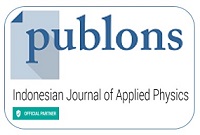Evaluating The Accuracy of Gridded Climate Datasets for Precipitation, Surface Air Temperature, and Sea Surface Temperature in Central Java, Indonesia
Abstract
Keywords
Full Text:
PDFReferences
1 Ma, J. et al. Hydrological cycle changes under global warming and their effects on multiscale climate variability. Ann. N. Y. Acad. Sci. 1472, 21–48 (2020).
2 Calvin, K. et al. IPCC, 2023: Climate Change 2023: Synthesis Report, Summary for Policymakers. Contribution of Working Groups I, II and III to the Sixth Assessment Report of the Intergovernmental Panel on Climate Change [Core Writing Team, H. Lee and J. Romero (Eds.)]. IPC. https://www.ipcc.ch/report/ar6/syr/ (2023) doi:10.59327/IPCC/AR6-9789291691647.001.
3 WMO. State of the Global Climate 2023. (United Nations, 2024). doi:10.18356/9789263113474.
4 Aboelkhair, H., Mohamed, B., Morsy, M. & Nagy, H. Co-Occurrence of Atmospheric and Oceanic Heatwaves in the Eastern Mediterranean over the Last Four Decades. Remote Sens. 15, 1841 (2023).
5 François, B. et al. Concurrent modes of climate variability linked to spatially compounding wind and precipitation extremes in the Northern Hemisphere. Earth Syst. Dyn. 16, 1029–1051 (2025).
6 Bhattacharyya, P., Pathak, H. & Pal, S. Impact of Climate Change on Agriculture: Evidence and Predictions. in Climate Smart Agriculture: Concepts, Challenges, and Opportunities 17–32 (Springer, 2020). doi:10.1007/978-981-15-9132-7_2.
7 Eryani, I. G. A. P. & Jayantari, M. W. Badung river basin sustainable water resources management for mitigate the effect of climate change. in AIP Conference Proceedings vol. 3110 020005 (2024).
8 Day, J. W. & Rybczyk, J. M. Global Change Impacts on the Future of Coastal Systems: Perverse Interactions Among Climate Change, Ecosystem Degradation, Energy Scarcity, and Population. in Coasts and Estuaries 621–639 (Elsevier, 2019). doi:10.1016/B978-0-12-814003-1.00036-8.
9 Putra, B. A. ASEAN’s climate change mitigation and adaptation measures: abandoning stagnant policy responses. Front. Clim. 6, 1488560 (2024).
10 Estiningtyas, W., Syahbuddin, H., Harmanto, Pramudia, A. & Dermoredjo, S. K. Analysis of key locations as indicators for extreme climate impacts in supporting climate change adaptation in Indonesia. IOP Conf. Ser. Earth Environ. Sci. 724, 012042 (2021).
11 Riantini, M., Listiana, I., Yanfika, H., Rohaini & Wiryawan, D. Vulnerability of poor fishermen household: The impact of climate variability in the Tanggamus district, Lampung Province, Indonesia. in AIP Conference Proceedings vol. 2563 020001 (2022).
12 Zaini, A. Z. A., Vonnisa, M. & Marzuki, M. Impact of different ENSO positions and Indian Ocean Dipole events on Indonesian rainfall. Vietnam J. Earth Sci. 46, 100–119 (2024).
13 Saptaningtyas, H. et al. Tidal flood and slow onset mobility in the urban community on The Northeast Coast of Central Java, Indonesia. BIO Web Conf. 155, 06004 (2025).
14 Sekaranom, A. B., Nurjani, E. & Nucifera, F. Agricultural Climate Change Adaptation in Kebumen, Central Java, Indonesia. Sustainability 13, 7069 (2021).
15 Hersbach, H. et al. The ERA5 global reanalysis. Q. J. R. Meteorol. Soc. 146, 1999–2049 (2020).
16 Funk, C. et al. The climate hazards infrared precipitation with stations—a new environmental record for monitoring extremes. Sci. data 2, 1–21 (2015).
17 Tresnawati, R., Wirasatriya, A. & Wibowo, A. Accuracy performance of satellite-derived sea surface temperature products for the indonesian seas. (2022) doi:http://dx.doi.org/10.21163/GT_2022.172.07.
18 Sojka, M., Ptak, M., Szyga-Pluta, K. & Zhu, S. How Useful Are Moderate Resolution Imaging Spectroradiometer Observations for Inland Water Temperature Monitoring and Warming Trend Assessment in Temperate Lakes in Poland? Remote Sens. 16, 2727 (2024).
19 Zhang, C. et al. The ARM Data-Oriented Metrics and Diagnostics Package for Climate Models: A New Tool for Evaluating Climate Models with Field Data. Bull. Am. Meteorol. Soc. 101, E1619–E1627 (2020).
20 Alsilibe, F., Bene, K., Bilal, G., Alghafli, K. & Shi, X. Accuracy assessment and validation of multi-source CHIRPS precipitation estimates for water resource management in the Barada Basin, Syria. Remote Sens. 15, 1778 (2023).
21 Ahmed, J. S., Buizza, R., Dell’Acqua, M., Demissie, T. & Pè, M. E. Evaluation of ERA5 and CHIRPS rainfall estimates against observations across Ethiopia. Meteorol. Atmos. Phys. 136, 17 (2024).
22 Jimma, T. B. et al. Spatiotemporal variability of soil moisture over Ethiopia and its teleconnections with remote and local drivers. Theor. Appl. Climatol. 151, 1911–1929 (2023).
23 Zhang, M., Wang, M., Guo, H., Hu, J. & Xiong, J. Tropospheric delay model based on VMF and ERA5 reanalysis data. Appl. Sci. 13, 5789 (2023).
24 Kim, K.-H., Shim, P.-S. & Shin, S. An alternative bilinear interpolation method between spherical grids. Atmosphere (Basel). 10, 123 (2019).
25 Frakusya, Z. A., Virgianto, R. H. & Yuggotomo, M. E. Estimasi Konsentrasi PM10 Menggunakan Support Vector Regression. JRST (Jurnal Ris. Sains dan Teknol. 6, 1 (2022).
26 Chicco, D., Warrens, M. J. & Jurman, G. The coefficient of determination R-squared is more informative than SMAPE, MAE, MAPE, MSE and RMSE in regression analysis evaluation. Peerj Comput. Sci. 7, e623 (2021).
27 Moreno, J. J. M., Pol, A. P., Abad, A. S. & Blasco, B. C. Using the R-MAPE index as a resistant measure of forecast accuracy. Psicothema 25, 500–506 (2013).
Refbacks
- There are currently no refbacks.
















